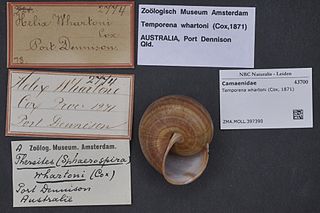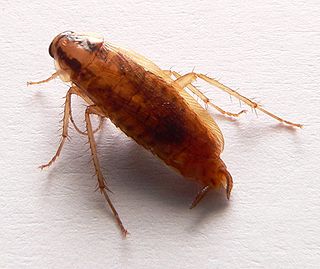
A pika is a small, mountain-dwelling mammal native to Asia and North America. With short limbs, a very round body, an even coat of fur, and no external tail, they resemble their close relative, the rabbit, but with short, rounded ears. The large-eared pika of the Himalayas and nearby mountains lives at elevations of more than 6,000 m (20,000 ft).

The Christmas imperial pigeon or Christmas Island imperial pigeon, also known as Black imperial pigeon, Dusky imperial pigeon, Wharton's imperial pigeon, or burong pergam, is a large imperial pigeon endemic to Christmas Island in the northeastern Indian Ocean. It has an overall grey-blue colouration, and juveniles are duller than adults. It makes a soft purring coo sound and a deeper whoo sound comparable to a cow mooing. It lays one glossy white egg per brood, and is possibly somewhat colonial.
Veigaiidae is a family of mites belonging to the superorder Parasitiformes. However they are not parasitic but free-living and predatory and are found in soil and decaying organic matter. Some species are specialists of rocky shorelines. Members of this family can be distinguished by a hyaline appendage on the tarsus of the pedipalp.
Gamasolaelaps is a genus of mites belonging to the family Veigaiidae. Males of this genus can be distinguished from other members of the family by the lack of spurs on the second pair of legs and the fact the sclerotized shields on the underside of the body are never fused together. Females are more difficult to diagnose, a high powered microscope being required.
Gamasolaelaps bellingeri is a species of mite belonging to the family Veigaiidae. The female is only 0.5 mm in length, the male even smaller. Both can be recognized by the dorsal sclerotized shield being deeply incised laterally. This species is found in damp habitats such as moss and leaf litter in Jamaica.

Sphaerospira is a genus of air-breathing land snails, terrestrial pulmonate gastropod molluscs in the family Camaenidae.

Temporena whartoni, common name the Holbourne Island banded snail, is a species of air-breathing land snails, terrestrial pulmonate gastropod molluscs in the family Camaenidae.
Gorirossia is a genus of mites in the family Veigaiidae.
Longolaelaps is a genus of mites in the family Laelapidae.
Raillietia is a genus of mites placed in its own family, Railletiidae, in the order Mesostigmata. Its name honours French parasitologist Louis-Joseph Alcide Railliet. It contains seven recognized species:

Polyaspididae is a family of mites in the order Mesostigmata.
Dyscritaspis is a genus of mites in the family Polyaspididae. There is at least one described species in Dyscritaspis, D. whartoni.
Gamasolaelaps aurantiacus is a species of mite in the family Veigaiidae.
Gamasolaelaps bidentis is a species of mite in the family Veigaiidae.
Gamasolaelaps excisus is a species of mite in the family Veigaiidae.
Gamasolaelaps praetarsalis is a species of mite in the family Veigaiidae.
Gamasolaelaps pygmaeus is a species of mite in the family Veigaiidae.

The giant pika or Wharton's pika is an extinct mammal species in the family Ochotonidae. It lived during the Pleistocene and early Holocene in northern parts of North America. Very similar forms have also been found also in Siberia.

Blattella is a genus of cosmopolitan and wild cockroaches in the family Ectobiidae.

Temporena is a genus of air-breathing land snails, terrestrial pulmonate gastropod molluscs in the subfamily Hadrinae of the family Camaenidae.






